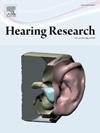Music to my ears
IF 2.5
2区 医学
Q1 AUDIOLOGY & SPEECH-LANGUAGE PATHOLOGY
引用次数: 0
Abstract
Both psychoacoustic and cochlear measurements of frequency selectivity in humans indicate that persons with substantial active musical experience can show higher selectivity values. The influence of experience on neural networks in the brain is compatible with what is known about learning and development and thus changes in frequency selectivity of elements in the auditory pathway. Assumed changes in cochlear selectivity as the result of experience, however, lack both any known anatomical substrate and precedent. Here, the data interpretations of Bidelmann et al. (2016) are questioned as not being parsimonious, and the suggestion is raised that in fact there are no changes in the cochlea of musicians. Instead, within the assumed large range of differences in human cochlear length, those persons with innately better cochlear selectivity are more likely to take up music as a career or pastime.
悦耳的音乐
对人类频率选择性的心理声学和耳蜗测量表明,具有丰富活跃音乐经验的人可以显示出更高的选择性值。经验对大脑神经网络的影响与已知的学习和发展是一致的,因此听觉通路中元素的频率选择性的变化。假设耳蜗选择性的改变是经验的结果,然而,缺乏任何已知的解剖学基础和先例。在这里,Bidelmann et al.(2016)的数据解释被质疑为不吝啬,并提出音乐家的耳蜗实际上没有变化。相反,在假定的人类耳蜗长度差异的大范围内,那些天生具有更好的耳蜗选择性的人更有可能把音乐作为一种职业或消遣。
本文章由计算机程序翻译,如有差异,请以英文原文为准。
求助全文
约1分钟内获得全文
求助全文
来源期刊

Hearing Research
医学-耳鼻喉科学
CiteScore
5.30
自引率
14.30%
发文量
163
审稿时长
75 days
期刊介绍:
The aim of the journal is to provide a forum for papers concerned with basic peripheral and central auditory mechanisms. Emphasis is on experimental and clinical studies, but theoretical and methodological papers will also be considered. The journal publishes original research papers, review and mini- review articles, rapid communications, method/protocol and perspective articles.
Papers submitted should deal with auditory anatomy, physiology, psychophysics, imaging, modeling and behavioural studies in animals and humans, as well as hearing aids and cochlear implants. Papers dealing with the vestibular system are also considered for publication. Papers on comparative aspects of hearing and on effects of drugs and environmental contaminants on hearing function will also be considered. Clinical papers will be accepted when they contribute to the understanding of normal and pathological hearing functions.
 求助内容:
求助内容: 应助结果提醒方式:
应助结果提醒方式:


